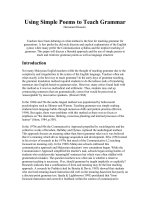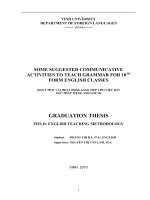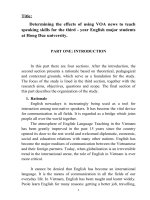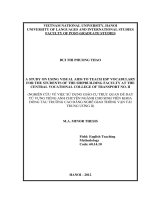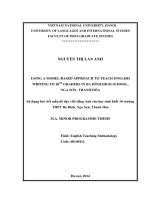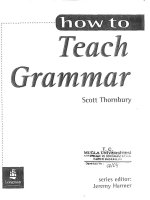Using Simple Poems to Teach Grammar
Bạn đang xem bản rút gọn của tài liệu. Xem và tải ngay bản đầy đủ của tài liệu tại đây (110.21 KB, 8 trang )
Using Simple Poems to Teach Grammar
Hawanum Hussein
Teachers have been debating on what method is the best for teaching grammar for
generations. A few prefer the old style discrete and explicit explanations of the English
syntax while many prefer the Communication syllabus and the implicit teaching of
grammar. This paper will discuss a blended approach and the use of simple poems to teach
and reinforce grammar points as well as language structure
Introduction
Not many Malaysian English teachers relish the thought of teaching grammar due to the
complexity and irregularities in the syntax of the English language. Teachers often ask
what exactly is the best way to teach grammar? In the early days of grammar teaching, the
grammar translation method required students to do the tedious tasks of translating
sentences into English based on grammar rules. However, many critics found fault with
this method as it was too methodical and arithmetic. Thus, students may end up
constructing sentences that are grammatically correct but would be perceived as
'unacceptable' by most native speakers. (Howatt 1984)
In the 1940s and 50s the audio-lingual method was popularized by behavioural
psychologists such as Skinner and Watson. Teaching grammar was simply making students
learn language habits through numerous drills and pattern practices.(Brown, 1994). But
again, there were problems with this method as there was no focus or emphasis on "the
intentions, thinking, conscious planning and internal processes of the learner" (Stern, 1984,
p.305).
In the 1970s and 80s the Communicative Approach propelled by sociolinguists and the
collective works of Krashen, Halliday and Hymes, replaced the audiolingual method. This
approach focuses on meaning rather than form (grammar rules) as it was believed that it is
meaning which drives language acquisition and development. Ellis (1994) noted in his
review of research in the 1970s that much of the Communicative L2 teaching focussed on
meaning only. In the 1980's Malaysian schools embraced this communicative approach and
Malaysian educators' own conundrum began. While the Communicative Approach
simplified the teacher's task, schools began seeing hordes of students who could provide
'meaningful' sentences but which were often riddled with grammatical mistakes. The
question teachers now often ask is whether a return to grammar teaching is necessary. If so,
should grammar be taught implicitly or explicitly? Research indicates that a combination of
form and meaning may be the best teaching approach. A research by Prabhu (cited by
Beretta & Davis, 1985) showed that students who received meaning-based instruction did
well on the meaning-based test but poorly on a discrete-point grammar test. Spada &
Lightbrown (1993) postulated that "form focussed instruction and corrective feedback
within the context of communicative interaction can contribute positively to second
language development in both the short and long term" (p.205). This is supported by Celce-
Murcia, Dornyei and Thurrell (1997) who suggest that the integration of form and meaning
is gaining importance in what they refer to as the 'principled communicative approach.'
Musumeci (1997) went on further to say that students should learn grammar explicitly but
should also be given the opportunity to practise them in communicative and authentic /
simulated tasks.
For Malaysian students for which English is a second language, for effective
communication, a knowledge of the rules is sorely needed. Pavel V. Sysoyev (2003)
stresses this need for L2 students to receive both form and meaning, which he labelled as
Integrative Grammar Teaching. Both fluency and accuracy are desirable and cannot be
taught in isolation. This paper will discuss an integrated or blended approach to teaching
and reinforcing grammar. For each kind of poem, specific teaching points will be
highlighted. Classroom experience and management such as immediate feedback and
correction will also be discussed.
Types of Poems Used in the Writing Class
The Intensive English Program at UNITEN is a preparatory, proficiency course designed
for school leavers who wish to enroll in UNITEN. In the writing class, a series of poems
were used to review and reinforce grammar rules the students should have 'learnt' while in
school. This was deemed necessary as most of the students have limited to average English
proficiency. The majority were Malaysians but there were three Arab speaking students
from Sudan and Yemen.
The following are writing activities adapted from Holmes and Moulton's "Writing Simple
Poems ."
Adjective Poems
Teaching Points
• Adjectives
• Adjectives after linking verbs
• Basic sentence structure
• Dictionary usage
The first few classes focused on parts of speech, and word class. The lesson began with a
revision of the basic structure of an English sentence. To help them students use the
structure, the adjective poem pattern was shown to them.
Pattern
Line 1 : Noun
Line 2 : Same noun + is or are + adjective
Line 3 : Same noun + is or are + adjective1, adjective 2
Line 4 : Is or are + adjective 1, adjective 2, adjective 3
Line 5 : Adjective 1, adjective 2, adjective 3, adjective 4
Line 6 : New related noun/
The following is an example of an adjective poem written and revised by a student :
Coffee
Coffee is bitter
Coffee is bitter, marvelous
Is bitter, marvelous, satisfying,
Bitter, marvelous, satisfying, splendid.
Coffee Bean
(Nur Asma Hussain, 18)
As the students wrote their poems, the teacher monitored their work and pointed out
problems with the structure and subject verb agreement. It was also observed that many
had problems with adjectives and used nouns to modify the subject.
A typical mistake would be : She is success.
Adjective Placement Poem
Teaching Points
• Adjectives
• Placement of Adjectives
• Subject Verb Agreement.
• Present Progressive Tense
To help students learn the placement of adjectives, an adjective placement poem was used.
The lesson began with the exploration stage in the Integrative L2 grammar lesson. The
teacher gave each group of students three sets of cards consisting of adjectives and a noun.
They were then given time to sort the adjectives out in the correct order and to explain
what grammar rule was used. After some discussion, they were shown the correct way to
order adjectives:
Order of Adjectives
1. determiners
2. possessive words
3. ordinal numbers
4. cardinal numbers
5. general description
6. size, height, length
7. shape
8. age, temperature
9. colour
10. origin
11. nouns as adjectives
12. head noun
(Holmes & Moulton, 2003)
To write the poem, students were told that they were going on a long trip and must decide
what to bring to keep them happy. After the writing stage, they were asked to exchange
papers and check the correct order of adjectives. This was done to introduce to them the
concept of peer editing which is an integral part of any process writing class. As this was
happening, the teacher went around to monitor the activity and asked students to correct
grammar mistakes in their poems as necessary. The following is an example of an adjective
placement poem :
Hawaii
I'm taking a trip to Hawaii
And I'm taking along my favourite things :
My sporty, new, brown Camel Active shoes,
A big, plasma TV,
One pack of Pokemon cards,
A comfortable, black, German sweater,
A pair of sexy, old swimming trunks,
And most important, my beautiful grandmother.
(Muhd. Zarif Kamrdin, 18)
Alphabet Poem
Teaching Points
• Verbs
• Past Tense
• Dictionary Usage.
• Cooperative Learning through group work
An alphabet poem can be used to teach parts of speech or sentence structure while
reinforcing dictionary skills. Since this kind of poem is rather long, students were put into
groups to write two kinds of alphabet poems. This group poem required the students to use
their dictionary extensively and to work together to collate group ideas into one group
poem As a warm up , each group was asked to list on the board all the things that could be
found in a teenager's closet alphabetically. To write the second poem, students had to start
each letter with a verb in the past tense. This enabled the class to revise their verbs in the
simple past tense while writing some wacky and often hilarious group poems :
What I Did The Last School Holidays (Verbs)
Accessed information from the internet
Babbled with my friend
Conversed with my principal
Donated some clothes to the orphanage
Escorted my best friend to see her boyfriend
Fought often with my sister
Gave my football cards to my friends
Hacked into the computer system
Insisted on colouring my room pink
Joined the army for a week
Kicked my neighbour's dog
Learned how to cook
Murdered my brother's girlfriend
Nagged my neighbour's daughter
Opposed my parents' plans to go to Langkawi
Puzzled why my parents went to Langkawi without me
Qualified to join the Newboyz group
Rebuilt my tree house after my brother threw stones at it
Sold my hand phone because it was broken
Took my young brother to his friend's house
Unfertilized the soil behind my backyard
Vandalized a bus stop with my friend
Waited for my girlfriend at the bus stop which I had vandalized
X-rayed my body
Yelled at the field
Zapped my discipline teacher's car.
(Mohd Zarif, Mohd Khairy, Nur Dalila, Mohd Khairul, Nur Syahida)
Adverb Poem
Teaching Points
• Verbs
• Adverbs
• Articles / Determiners
• Phrases
• Clauses
• Dictionary usage
